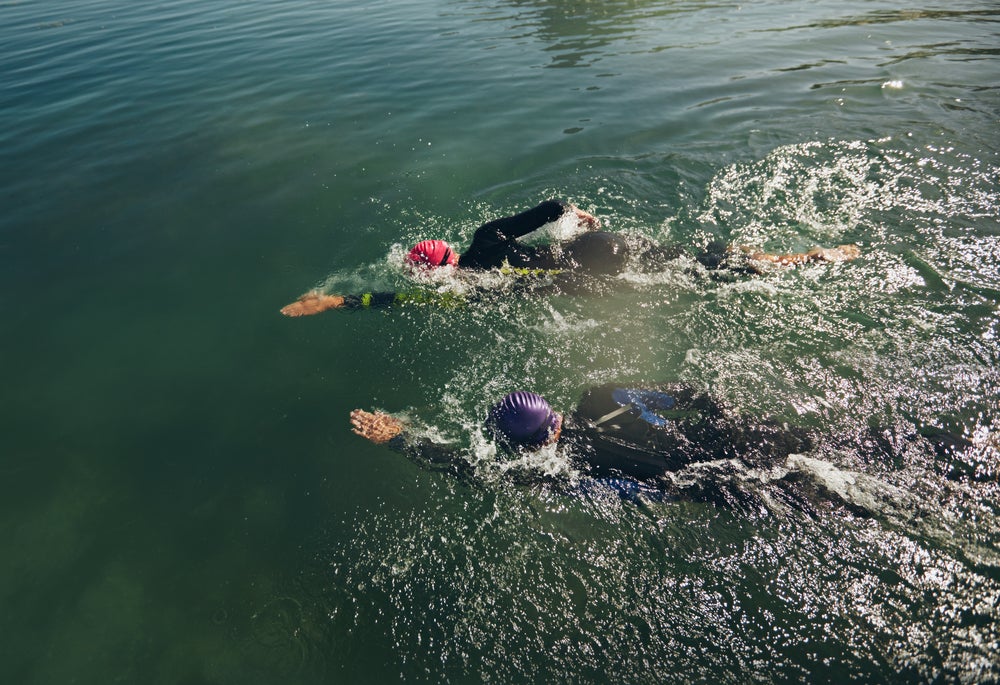Med Tent: Shouldering Through

Photo: <a href=http://shuterstock.com>Shutterstock.com</a>
Don’t let shoulder bursitis, a swimming overuse injury that often accompanies an impingement or rotator cuff strain, keep you out of the pool.
Shoulder bursitis (technically subacromial bursitis) is marked by a raw, burning pain at the front or side of the shoulder. Loss of motion in the shoulder can also be a symptom of bursitis. The pain increases with overhead activities such as throwing or swimming, and the pain may also increase if you lean on your elbow.
Bursae are fluid-filled shock absorbers located between a bone and a muscle, tendon or skin. In the shoulder’s case, the subacromial bursa interacts with the rotator cuff and the surrounding bones, especially the acromion, which is part of the scapula (shoulder blade).
The bursa in this area can become irritated and cause pain. It’s common for subacromial bursitis to accompany shoulder impingement or rotator cuff strain, but it can have a variety of causes. The most typical ones for athletes are rotator cuff weakness, shoulder instability, a shoulder impact and overuse, especially in overhead sports like baseball, tennis, swimming and volleyball.
Fix It
See a doctor. The shoulder is a complex and important joint, so see a sports doc at the first sign of shoulder pain.
Employ dynamic rest. Lay off the upper-body work (including swimming), and use lower-body workouts to maintain fitness.
Ice it. Ice applied to the shoulder for 15 minutes several times a day can help reduce inflammation.
Try an NSAID. An anti-inflammatory like ibuprofen or naproxen can help with the pain.
Start rehabbing. As the pain improves, do some rotator cuff exercises to help strengthen your shoulder. Here are two.
Shoulder Squeeze #1
Lie facedown on an exercise bench. Hold your arms out to your sides parallel to the floor, bent at 90 degrees with your thumbs pointing toward the ceiling. Now try to raise your elbows toward the ceiling and feel your shoulder blades squeezing together. Hold for a moment and return to the starting position. Do 10 to 20 reps depending on your strength.
Shoulder Squeeze #2
While lying facedown on the bench, hold your arms along your sides with your palms up. Keeping your arms straight, lift your palms toward the ceiling, again feeling your shoulder blades squeeze together. Hold for a moment and return to the starting position. Again, do 10 to 20 reps.
RELATED: Shoulder Exercises For A Stronger Swim
Prevent It
Work the shoulder both ways. Having a strong, balanced shoulder is the best injury-prevention strategy—strong muscles take the strain off tendons, cartilage, bones and of course bursae. Even better here: The muscles in and around the shoulder respond well to exercise. Shoulder work must be a staple of your upper-body workouts, and you must work opposing muscle groups to avoid an imbalance. That means, for example, that if you do a pushing exercise (such as bench presses or overhead presses), you need to do an equivalent amount of a pulling movement (like rowing or pullups). Also, add in some rotator cuff exercises like the ones above.
Swimmers, improve your mechanics. Learning proper technique straight out of the gate is the best way to start. If you’re already a dedicated water rat, a good swim coach can spot and correct any mechanical flaws you have that could cause injury.
RELATED: Is Your Sleep Position Contributing To Your Injuries
Exercise #1: Serratus Chair Shrug
Sit upright on a chair or bench and place your hands flat on the sitting surface next to your hips. Completely straighten your arms. Allow your shoulders and back muscles to relax so your torso lowers between your shoulders. Your hips should just be off the edge of the bench. Press your shoulders down as you lift your upper body. Your torso should rise between your shoulders. Pause for 5 seconds, then lower your body back to the starting position.
RELATED VIDEO: An Exercise To Increase Shoulder Strength
Exercise #2: Inverted Shoulder Press
Assume a pushup position, but place your feet on a bench or chair and push your hips up so that your torso is nearly perpendicular to the floor. Your hands should be slightly wider than your shoulders, and your arms should be straight. Without changing your body posture, lower your body until your head nearly touches the floor. Pause, then return to the starting position by pushing your body back up until your arms are straight.
New York City sports medicine specialist Jordan D. Metzl, M.D. is a 29-time marathon finisher and 13-time Ironman. His book, The Athlete’s Book of Home Remedies, has more than 1,000 tips to fix all types of injuries and medical conditions.
From The Athlete’s Book of Home Remedies by Jordan D. Metzl, M.D. with Mike Zimmerman. Copyright 2012 by Rodale Inc. Published by arrangement with Rodale, Inc., Emmaus, PA 18098.